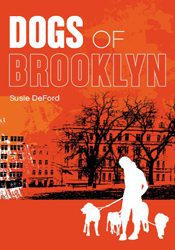
When poets decide to collect what they consider to be some of their best work into a manuscript, there are seemingly thousands of choices to make. Should all the poems be similar in style? What about subject? Should the order jump between long, free verse pieces and short, witty epithets? To an outsider, poets’ choices might seem random and thoughtless, but that is usually far from the case. Poets string their poems together delicately, weaving together even the smallest details in an attempt to construct a masterpiece.
Susie DeFord’s debut poetry collection, Dogs of Brooklyn tells us immediately what her collection is going to be about. Released in Spring 2012 from the aptly named Dog Poet Laureate Press, Ms. Deford finds inspiration from her time walking and taking care of dogs in New York. She takes the oft-used trope of walking through and experiencing a city, and invites us to see her world through her eyes.
In an interview with this site in February, DeFord talked about how she fell into working with dogs as a way to make money while also having time to write. She wanted to find a job that would give her experience and inspiration to draw from, and “dog training particularly is amazing because I get to help dogs and their people have better lives together.” The collection shows just how much she enjoyed and experienced in her time training and walking dogs. Many of these poems invoke great images and emotions. Unfortunately when so many poems center on one such theme, they aren’t all going to work.
The author does, however, do a great job of switching up her style in a way that paces the collection quite well. Two poems that showcase this juxtaposition quite well are “The Burroughs of Brooklyn” and “Lampyridae.” The former is the typical walk-through-the-city poem that is found so often in this collection; the speaker’s encounter with a local drug addict and William Burroughs-look-alike evokes the feel and emotion of Brooklyn in a subtle, colorful manner. Immediately following that, “Lampyridae” allows the speaker to be vulnerable and admit that everything isn’t perfect, that living in New York can really drag you down sometimes.
This collection’s greatest strength is found in the numerous poems that showcase the best of Ms. DeFord’s chosen genre. The whole “walking through the city” trope has been used in all kinds of literature, from Ulysses to Teju Cole’s novel Open City. If a contemporary writer is going to try and tackle this, she must do something to make it stand above the rest. The poem “Mystery Woman Of The Coney Island Cyclone” is chock full of absolutely gorgeous images that transport the reader to where the poem is taking place, and we actually feel as if we’re seeing everything through the speaker’s eyes.
Metal clanking chinkity chink chink chink
and wood saw splinter? Gravity pulls
shoulders back, eyes to the sky’s lemon-
apple sun, sweet-sour.
This image alone is a barrage to the senses, and immediately draws me in to the poem’s sacred universe. Too often poems don’t grip us enough to shake us from our surroundings—that’s usually the role of fiction. But poems like this are pure escapism, making me long for its world long after the final lines trail off.
Maybe another passenger would blow the sticky
sting instead of just blowing the scene? Maybe
he’d be tall and sweet, stop this ride so we could
watch the firecrackers bang to thin pieces of colored
tissue rain from the cloudy puff of smoke on a July’s eve.
As mentioned above, the decision of what poems to put in a book and how to order them can be a stressful ordeal for a poet. If it’s decided that the whole collection is going to follow a simple theme or trope, it can heap tons of pressure on the poet to keep things consistent. While Ms. DeFord is very flexible in terms of form and style, she manages to keep almost all of the poems geared toward her central themes. This is problematic with a few of them, such as “Bang Loud Long” which feels full of recycled images and amateurish observations.
We bang around Brooklyn summer streets’ sticky
stink, trash cooking on the sidewalks in big black
bags.
For me, the sounds and images were trying to be too clever for their own good and subsequently fell a bit flat.
The only other real problem I had with this collection was its use of photographs to accompany/split some of the poems. Many of them are pictures of landscapes/scenery or dogs, which are related to the subjects and themes of the book, but they hinder the poems’ effects rather than enhance them. I’m sure Ms. DeFord wanted to get some pictures to show readers the dogs she took care of or the things that she saw on her walks, but she should be confident enough in her poetry to form those images without the need of pictures. It makes me think that the author was hoping to sell her books only to dog lovers or people who would rather look at pictures than read poetry.
The collection is full of excellent poetry, and I would love to see Ms. DeFord release a more broadly-influenced collection in the future. A few times I felt myself get weary of all the dogs and Brooklyn building images, but the author’s talent more than made up for her lack of subject diversity. I definitely recommend this collection to anyone interested in life in New York, life as a dog trainer, or just someone who wants to read explosive, image-saturated poetry.




